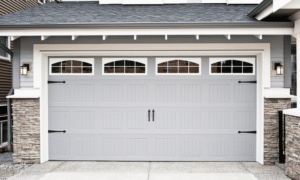In the realm of garage door functionality, springs perform an often-overlooked yet vital role. Despite their unassuming nature, these components are indispensable for the seamless operation of both manual and automatic garage door spring replacement. They shoulder the door’s weight during opening and closing, ensuring smooth movement, preventing abrupt drops, and prolonging the life of other intricate parts within this complex mechanism.
In a market teeming with various spring types like torsion and extension springs, selecting the right replacement demands a comprehensive understanding of each type’s unique characteristics and compatibility with specific door designs.
The process of replacing worn-out springs goes beyond routine maintenance; it’s a proactive strategy that enhances overall door performance. This practice can prevent inconvenient and potentially hazardous situations, such as sudden door malfunctions or sluggish response times, which often result from faulty springs. The benefits extend further than mere operational efficiency. Investing in regular spring replacements conveys a commitment to safety and reflects prudent homeownership decisions.
By delving into this topic, readers will gain insights into making informed choices about maintaining their garage doors, simultaneously fostering a sense of belonging to a community that values functionality, aesthetics, and long-term durability.

Grasping the Role of Springs in Door Operation
The functionality of a garage door is intricately tied to the efficiency of its springs, which play a pivotal role in both lifting and closing.
These springs act as counterbalances, making it possible to open and close the door with minimal effort. When the garage door descends, tension in these springs increases – storing potential energy to assist in lifting the door again.
Conversely, when the door opens, this energy is released, facilitating smooth operation. Understanding this fundamental principle underscores the importance of springs.
Two primary types of garage door springs replacement exist: torsion and extension springs. Torsion springs work via torque rotation around an axis, while extension springs extend or stretch under force. Each type has unique characteristics suitable for different door types and usage patterns. Therefore, meticulous assessment is vital when choosing between them.
For instance, torsion springs are generally more durable and safer than extension springs, albeit with higher initial costs. On the other hand, extension springs are cost-effective options for lighter doors but may necessitate more frequent maintenance and replacements due to wear and tear.
Properly maintaining these components not only extends their lifespan but also enhances overall door performance while upholding stringent safety measures. The inability of deteriorated springs to balance forces efficiently can accelerate wear on other components within your garage system, potentially leading to extensive repairs or even complete overhauls when a simple spring replacement would have sufficed initially.
Hence, periodic inspections are essential preventative measures. Timely identification of fatigue or damage prevents these issues from escalating, keeping your residential space secure. It also cultivates a sense of belonging by ensuring sustained functionality and durability within your home.
The Process and Benefits of Replacing Worn-Out Springs
It’s intriguing to consider how the replacement of worn-out springs can substantially extend your garage door’s lifespan and improve its functionality.
The degradation of these critical components is inevitable over time, attributed to continuous usage and exposure to environmental factors. However, proactive replacement of these deteriorating springs ensures your garage door operates smoothly and efficiently for an extended period.
The process of replacing worn-out springs involves several intricate steps. It requires an in-depth understanding of different garage door types and their mechanisms. Initially, it’s imperative to accurately determine the type and size of the existing spring. Each door demands specific springs based on its weight and height. After safely releasing tension from the old spring, it’s removed and replaced with a new one. The new spring is then wound up to generate sufficient force for lifting the door. Ideally, this process should be executed by trained professionals, as amateur attempts might result in accidents or further damage to other components.
The benefits derived from this preventive maintenance strategy are multifaceted. Beyond prolonging functional longevity and ensuring seamless operation, timely spring replacements reduce potential risks associated with sudden breakdowns or failures. Moreover, homeowners enjoy peace of mind, knowing their vehicle’s protection remains robust. It also fosters a sense of belonging among conscientious homeowners who take pride in maintaining their homes, while encouraging their community to do the same.

